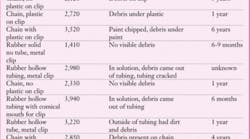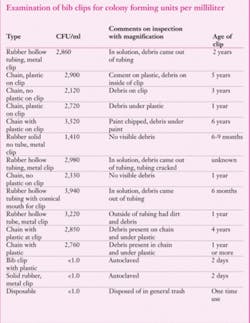by Noel Kelsch, RDHAP
[email protected]
She stood holding a bib chain in her hand, gently swirling it as I prepared lunch. We often brought the clip into the kitchen to save our street clothes from the ravages of baked ziti and the turbulence of tamale pie. I watched the chain go back and forth and realized that something was coming from it. On closer examination, we discovered that debris was falling from the balls that made up that chain. Bib clips and other items with hidden reservoirs can be a source of cross-contamination when they come in contact with moisture or dislodged debris and contaminate the patient or environment.
The Centers for Disease Control and Prevention defines cross-contamination as the act of spreading bacteria and viruses from one surface to another. Since blood-borne viruses can live on objects and surfaces for up to a week, germs could be spread when surfaces are not disinfected the right way or if equipment is not cleaned and sterilized between patients.
Each day that I put that clip in place, I felt guilty and decided it was time to find out exactly what risks I was taking and developed a simple solution to my observation. I decided to agar plate a variety of clips and see exactly what I was sharing with my patients. I gathered 12 clips from a variety of offices and placed them in sterile pouches, plated them out and did a count of the results after 48 hours of incubation. Each office reported they had disinfected the item using a hospital grade disinfectant but had never sterilized the item or put it in the ultrasonic bath.
Just so you know
CFU is a measurement of colony forming units of viable bacteria or fungal numbers. The method I used was to agitate the clips in sterile saline and plate out on agar (see related chart). It was incubated for 48 hours and a count was done. The count is given in CFU/mL (colony forming units per milliliter). The Environmental Protection Agency has established a limit of 500 cfu/ml for drinking water.
What I discovered:
- Bib clips and other items can be a source of cross-contamination. In their crevices, they can harbor pathogens.
- When the hollow bib clip was placed in solution, it released debris out of the tubing and had some of the highest CFU/mL counts. In the moist dental environment we work in, cross-contamination could occur in the same manner.
- The larger the inaccessible area, or “hidden” surface area the higher the CFU/mL count. The clip that had a plastic mouth with many crevices and indentations and the chain that had flaking paint and an inaccessible plastic ring had the highest co00unts.
- The solid rubber bib clip with limited indentations and crevices had the lowest number of CFU/mL.
- The autoclaved and the disposable bib holders did not create enough CFU/mL to be considered a source of viable pathogens.
Solutions
- Use disposable bib holders. They are simple to use, cost effective, and limit cross-contamination.
- Use bib holders with no chains, limited embossing, and no crevices. Do not buy clips that cannot be sterilized (most can). Put one in each setup, run through the ultrasonic bath to remove debris, and then sterilize.
- Do not bring any dental equipment into the area set aside for food in the dental setting. The chance of cross-contamination is not worth the risk.
Bib clips and other items with hidden reservoirs can be a source of cross-contamination. Every health-care professional has the responsibility of protecting patients and themselves from the risk of cross contamination.
About the Author
Noel Brandon Kelsch, RDHAP, is a syndicated columnist, writer, speaker, and cartoonist. She has received many national awards and owns her dental hygiene practice that focuses on access to care for all. She has devoted much of her 35 years in dentistry to educating people about the devastating effects of methamphetamine and drug use. She is immediate past president of the California Dental Hygienists' Association, on the board of directors for the Simi Valley Free Clinic, and is a five-time winner of the Castroville Artichoke Cook-off. She can be reached at [email protected].







